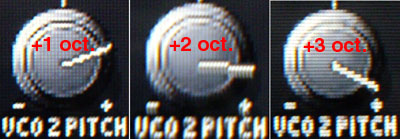You can raise the pitch of the 2nd oscillator by turning the knob to the right and lower it by turning to the left. Now that the obvious is out of the way, let's see the knob position for pitch shifts of 1, 2 and 3 octaves toward the positive side (the negative side behaves the exact same way).
It's very easy to do! You play the exact 2 same pitches (with legato) on synth1 and synth2, raise the pitch by 1 octave on synth2 (using the octave knob) and tune synth1's 2nd oscillator (the 1st oscillator being silent, that is, mix all the way to the right) to synth2's raised pitch. You could alternatively play notes that are 1 octave higher on synth2 and not touch the octave knob. That's all there is to it. You do the same thing for 2 and 3 octave shifts and you're pretty much done.
Of course, you could use your favorite audio editing software to do the same thing. Recall that the pitch frequency doubles as you go up 1 octave in case the software doesn't give you the note that corresponds to the pitch.
To be more thorough, one could also calibrate for semi-tones (half-steps) using the same basic technique. As a side note, there are 12 semi-tones in an octave. Interesting, no?

Knob positions for positive pitch shifting of 1, 2 and 3 octaves.
No comments:
Post a Comment